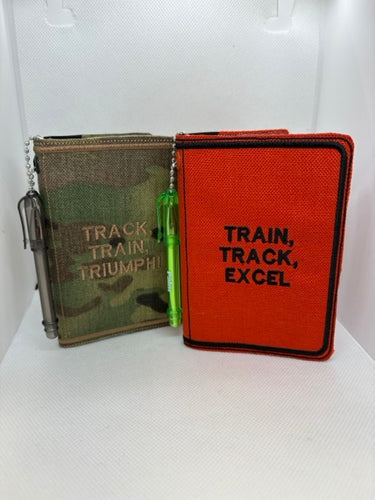
The Importance of a Training Notebook: Tracking Your Dog’s Progress and Setbacks
Partager
Training your dog is a journey—one filled with successes, challenges, and moments of growth. Whether you’re working on basic obedience, agility, or more specialized training, keeping track of your progress is essential for success. One of the most valuable tools in your training toolkit is a training notebook. A training notebook allows you to record every step of your dog’s development, helping you reflect on progress, identify patterns, and adjust your approach as needed.
Why Keep a Training Notebook?
- Track Progress Over Time: A training notebook provides a way to track your dog’s progress, helping you see how far you’ve come over weeks, months, and even years. It’s easy to get caught up in the moment and think things aren’t improving, but by looking back at your notes, you’ll be reminded of the small wins and the consistent effort you’ve put in.
- Identify Patterns and Triggers: Not all training sessions go as planned, and sometimes setbacks occur. A training notebook allows you to identify patterns in behaviour and triggers that might be influencing your dog’s actions. For example, if your dog starts acting fearful or anxious in certain situations, a notebook can help you pinpoint when those behaviours first started and what might have triggered them.
- Learn from Setbacks: Setbacks happen, and they don’t have to be discouraging. In fact, they can be valuable learning experiences. By writing down setbacks and reflecting on them, you can analyze what went wrong and develop a new strategy to overcome challenges. A training notebook is a great way to record specific incidents and use them as teaching moments for both you and your dog.
- Customize Your Approach: Every dog is unique, and sometimes you’ll need to adjust your training methods to better suit your dog’s personality and needs. A training notebook helps you keep track of what works and what doesn’t, so you can tailor your approach to each individual dog. It’s also a helpful tool if you’re working with a trainer, as it allows you to provide them with detailed feedback about your dog’s behaviour and progress.
How to Use a Training Notebook
Here’s how to make the most of your training notebook and why it's especially valuable when dealing with specific incidents and progress:
Record the Date and a Summary of the Day’s Training
Every day, write down the date and a summary of your training session. Include what you worked on, how the session went, and your dog’s overall behaviour. Was your dog more focused than usual, or did they seem distracted? Did they master a new skill, or was there something that didn’t go as planned?
Example Entry: Dec 2, 2024: Morning training session Karma’s First Snow of the Year
Today was Karma’s first time experiencing snow. We were working on the balance board, but Karma slipped off it after a snowfall. She didn’t seem to hurt herself, but she was a bit shaken up after the slip.
Record Specific Incidents or Concerns
If something significant happens during training—such as a behaviour issue, injury, or sudden fear—write it down. This helps you keep track of important moments and evaluate if they require any follow-up.
Example Entry: Dec 23, 2024: Karma’s Fear of the Balance Board
Karma seems to have developed a fear of the balance board. She’s been avoiding it during training sessions, which is a clear shift in her behaviour. I looked back at my notes and saw that on Dec 2, she slipped off the board after a snowfall. This may have been the triggering event. We’ll take our time reintroducing the balance board, starting with just a quick touch and building her confidence back up.
Reflect and Plan Next Steps
Use your notebook to reflect on what happened and to plan your next steps. If a setback occurs, figure out what changes need to be made in your approach. If you notice your dog is having trouble with something, adjust the difficulty level or break the task down into smaller, more manageable steps.
Example Entry: Dec 23, 2024: Next Steps with the Balance Board
Karma’s fear of the balance board seems to stem from the slip on Dec 2. I’ll take things slow, reintroducing the board to her in a calm, low-pressure way. I’ll reward her for just standing near it at first, and then gradually build up to more challenging exercises as her confidence grows. I’ll keep an eye on her behaviour and make adjustments as needed.
Introducing Our New Mini Training Notebooks
To help you stay organized and motivated during your training journey, we’re excited to announce the launch of our new mini training notebooks! These handy notebooks feature reusable covers with inspirational training quotes to keep you focused and motivated, no matter where you are in your dog’s training process. Whether you’re jotting down daily progress or reflecting on challenges, our mini notebooks are the perfect tool to support your training routine.
A training notebook is an essential tool for any dog owner committed to helping their dog reach their full potential. By tracking each training session and noting any incidents or setbacks, you’ll gain a deeper understanding of your dog’s behaviour and progress. Plus, when challenges arise, you’ll have a detailed record to help you find solutions and adjust your approach.
Get yours Here: https://humbledog.ca/products/mini-training-notebook
Remember, training is a process, and it’s normal for setbacks to occur. By taking the time to record these moments in your notebook, you’ll be able to create a training plan that’s tailored to your dog’s needs and personality. Whether you’re dealing with a fear, a setback, or a breakthrough, your training notebook will be there to help guide you through the journey.
Do you keep a training notebook for your dog? Share your experiences and tips in the comments—we’d love to hear how you track your dog’s progress!